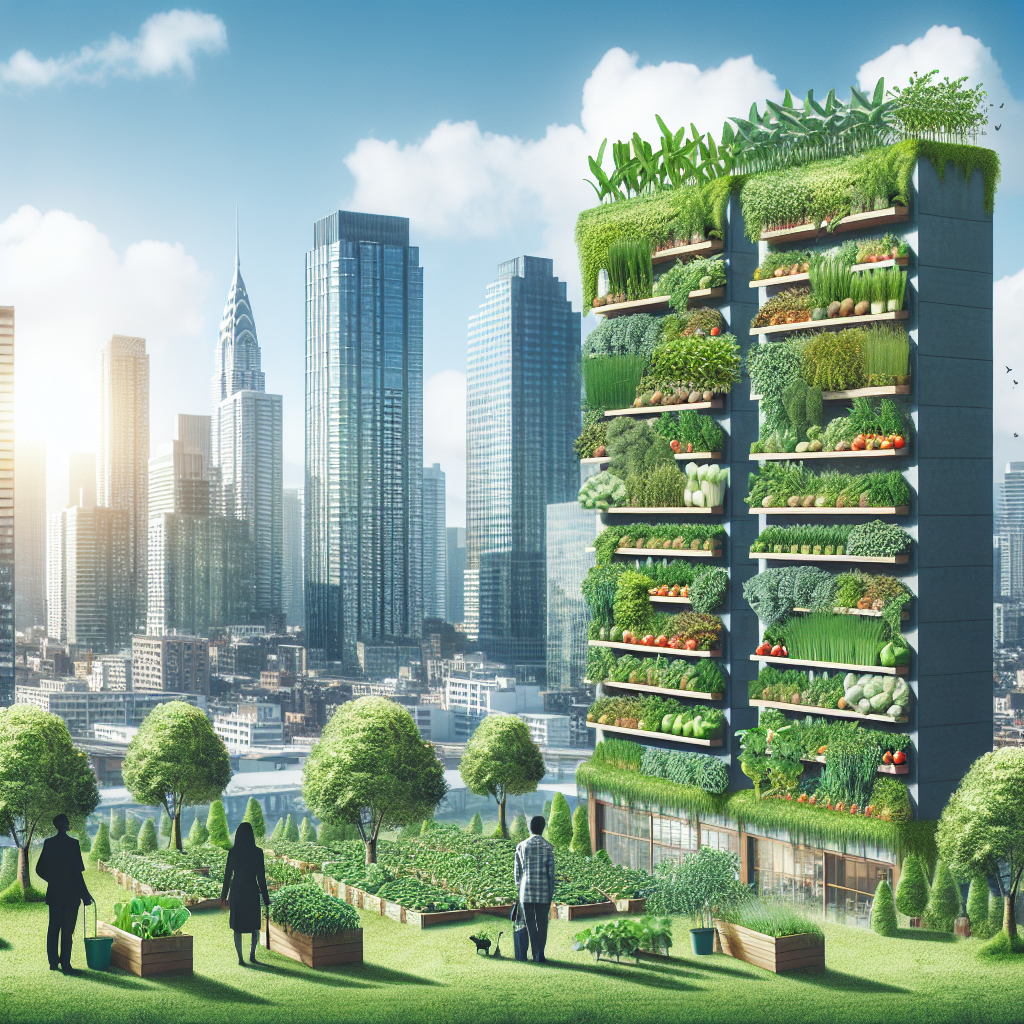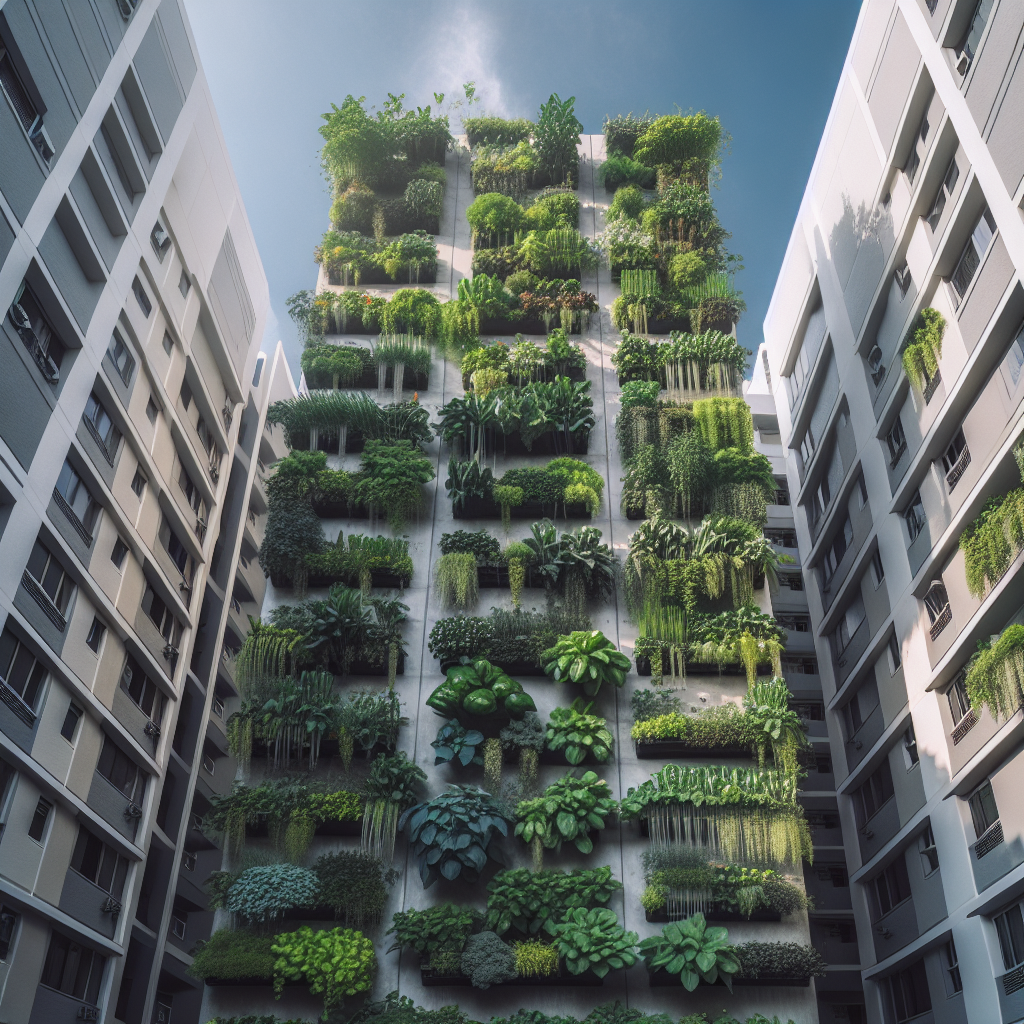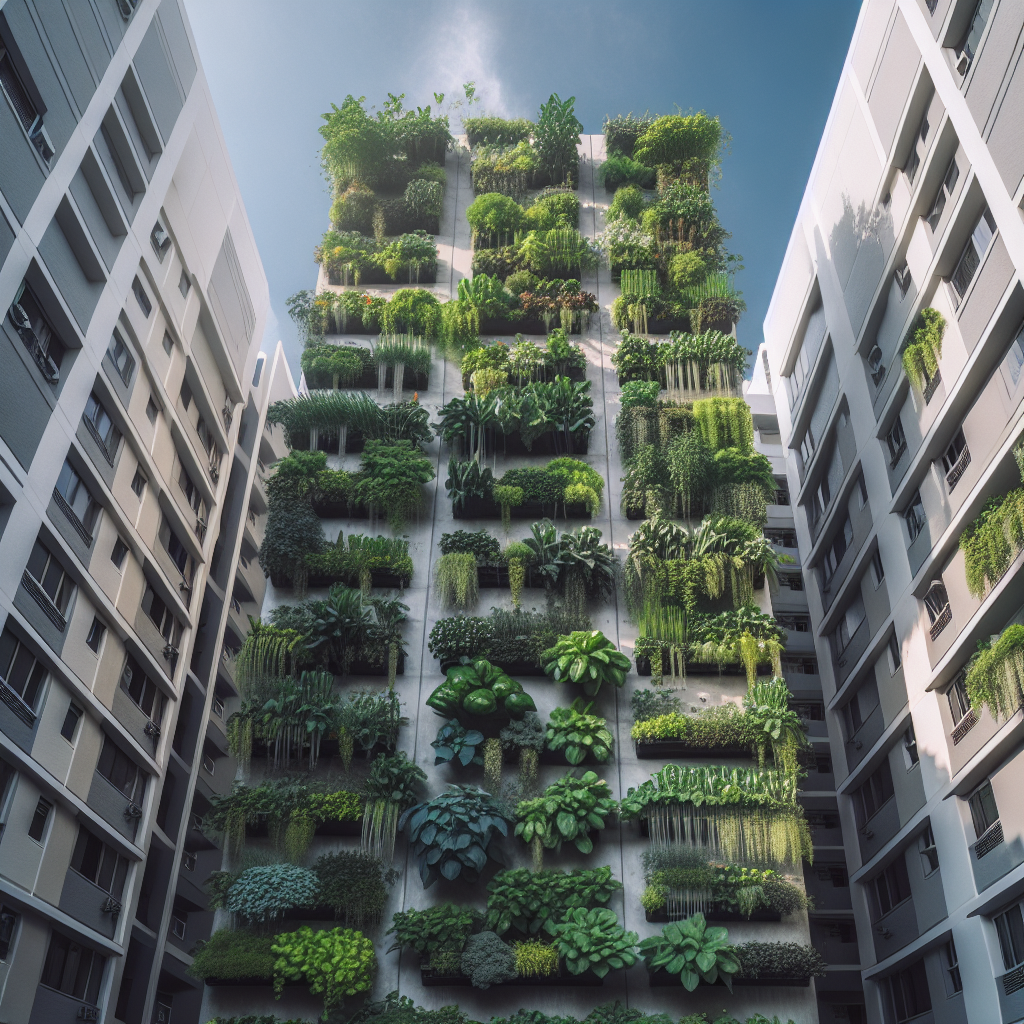Imagine transforming a concrete jungle into a vibrant green oasis. With vertical gardening, this dream becomes a reality. In urban spaces, where land is limited and precious, vertical gardening offers a revolutionary solution. By utilizing walls and vertical structures, you can create a lush, thriving garden that not only adds beauty to your surroundings but also provides numerous benefits. From improving air quality to promoting mental well-being, vertical gardening has the power to transform cityscapes into sustainable and healthier environments. Discover the endless advantages of vertical gardening in urban spaces and embark on a journey of urban greenery.
Increased Access to Green Spaces
In bustling cities where concrete jungles dominate the landscape, finding green spaces can be challenging. However, there is an increasing awareness of the importance of incorporating nature into urban environments. By creating more green spaces in cities, we can improve mental health and enhance the overall well-being of residents.
Improves mental health
Spending time in nature has been proven to have a positive impact on mental health. Green spaces provide a serene and calming environment that can alleviate stress, anxiety, and depression. The sounds of chirping birds, the sight of blooming flowers, and the fresh scent of grass can elevate your mood, helping you feel more relaxed and rejuvenated.
Promotes relaxation
Urban living can be hectic, with constant noise and a fast-paced lifestyle. Green spaces offer a much-needed respite from the chaos, allowing you to escape and unwind. Whether it’s taking a leisurely stroll through a park or finding a peaceful sanctuary in a nearby botanical garden, these green spaces offer moments of tranquility and quiet reflection.
Enhances overall well-being
Green spaces have a positive impact on our physical health as well. People who have access to green areas are more likely to engage in outdoor activities, such as walking, jogging, or cycling. These activities contribute to improved cardiovascular health, lower blood pressure, and increased stamina. Additionally, exposure to natural light and fresh air can boost our immune system and improve sleep quality, leading to an overall improvement in well-being.
Maximization of Space
One of the challenges in urban areas is the limited space available for traditional gardening methods. Vertical gardening offers a solution by utilizing vertical surfaces to optimize space and maximize the potential for greenery in small areas.
Utilization of vertical surfaces
Vertical gardening involves growing plants vertically, either on walls, fences, or specially designed structures. By making use of vertical surfaces, you can transform bare walls into vibrant green backdrops, adding beauty and greenery to otherwise bland spaces. It allows you to take advantage of unused vertical space and transform your surroundings into lush and thriving gardens.
Ideal for small spaces
In densely populated cities where space is a premium, vertical gardening proves to be a boon for urban dwellers. Whether you live in an apartment or have a small balcony or patio, vertical gardening enables you to grow a variety of plants without requiring much floor space. By utilizing vertical space, you can create a lush oasis in even the smallest of areas.
Increased food production
Vertical gardening is not limited to ornamental plants; it also offers an opportunity to grow your own food. Imagine enjoying fresh herbs, vegetables, and even fruits grown right in your urban dwelling. Vertical gardens, with their efficient use of space, allow urban farmers to cultivate a wide range of produce, reducing reliance on long-distance transportation and promoting sustainability.

Improvement of Air Quality
Urban areas often suffer from poor air quality due to high pollution levels. Vertical gardening can contribute to the improvement of air quality by reducing air pollution, filtering out toxins, and increasing oxygen production.
Reduces air pollution
The leaves of plants act as natural filters, absorbing pollutants such as carbon dioxide, nitrogen dioxide, and particulate matter. By growing plants vertically, we can increase the surface area for absorption, effectively reducing the concentration of harmful pollutants in the air. This has a direct impact on the respiratory health of urban dwellers, providing cleaner and fresher air to breathe.
Filters out toxins
Plants have the remarkable ability to absorb toxins from the environment. Vertical gardens act as natural purifiers, filtering out harmful substances present in the air, such as volatile organic compounds (VOCs) and volatile toxic chemicals. By creating more vertical gardens in urban areas, we can significantly reduce the exposure to these toxins, enhancing the overall health and well-being of residents.
Increases oxygen production
Photosynthesis, the process by which plants convert carbon dioxide into oxygen, is crucial for our survival. By incorporating more green spaces in urban areas, especially in the form of vertical gardens, we can enhance oxygen production. This increase in oxygen levels can have numerous benefits, including improved cognitive function, increased energy levels, and a sense of well-being.
Mitigation of Urban Heat Island Effect
Rapid urbanization has led to the “urban heat island” phenomenon, where cities are significantly warmer than surrounding rural areas. Vertical gardening plays a role in mitigating this effect by reducing ambient temperature, providing shade, and decreasing energy consumption.
Reduces ambient temperature
Tall buildings, concrete surfaces, and lack of greenery contribute to the excessive heating of urban areas. Vertical gardens help combat this by reducing ambient temperature through evaporative cooling. As plants transpire, they release water vapor into the air, creating a cooling effect that can significantly lower the temperature in their immediate surroundings. By incorporating vertical gardens in urban spaces, we can counteract the urban heat island effect and create more comfortable environments for residents.
Provides shade
Vertical gardens not only lower the temperature through evaporative cooling but also provide shade. The foliage of vertical plants acts as a natural canopy, offering shelter from the scorching sun. This shade not only provides relief from direct sunlight but also helps to reduce the temperature of surrounding surfaces, such as walls and pavement. By incorporating vertical gardens, we can create shaded areas where people can seek respite from the heat and enjoy the outdoors comfortably.
Decreases energy consumption
The cooling effect of vertical gardens can result in reduced reliance on air conditioning systems, thus decreasing energy consumption. By adopting vertical gardening in urban areas, we can contribute to energy conservation, reduce greenhouse gas emissions, and promote sustainability. This not only benefits the environment but also helps to lower electricity bills for urban residents.

Reduced Noise Pollution
Urban areas are notorious for their noise pollution, with constant traffic, construction, and other urban activities. Vertical gardens offer a natural solution by absorbing sound waves, creating a peaceful environment, and improving the quality of life for urban dwellers.
Absorbs sound waves
The dense foliage of vertical gardens acts as a barrier, absorbing and diffracting sound waves as they travel through the air. This natural acoustic insulation helps to reduce the impact of noise pollution in urban areas, creating a more tranquil environment. By incorporating vertical gardens along busy streets or near buildings, we can effectively mitigate the detrimental effects of noise pollution and improve the overall well-being of residents.
Creates a peaceful environment
Imagine stepping out of your apartment into a serene oasis amidst the hustle and bustle of the city. Vertical gardens provide a visual barrier from the surrounding noise and chaos, creating a peaceful and soothing environment. The calming presence of greenery and the gentle rustling of leaves can help to alleviate stress and anxiety, allowing urban dwellers to find solace in nature.
Improves quality of life
Noise pollution has been linked to various health issues, including high blood pressure, cardiovascular problems, and sleep disturbances. By reducing noise levels through the incorporation of vertical gardens, we can significantly improve the quality of life for urban residents. The ability to enjoy tranquility and peace within the urban landscape is invaluable, contributing to overall well-being and happiness.
Enhancement of Biodiversity
Urban areas often lack biodiversity, with vast stretches of concrete dominating the landscape. Vertical gardening provides an opportunity to attract pollinators, provide habitat for wildlife, and preserve native plant species.
Attracts pollinators
The vertical gardens filled with vibrant flowers and foliage act as beacons for pollinators, such as bees, butterflies, and birds. These beneficial creatures play a crucial role in pollinating plants, ensuring the reproduction of various plant species, including food crops. By creating vertical gardens that provide nectar and pollen sources, we can help support local pollinator populations and contribute to the conservation of these vital species.
Provides habitat for wildlife
Urban areas are often characterized by a lack of natural habitats for wildlife. Vertical gardening creates small but significant havens for birds, insects, and other creatures. The dense vegetation of vertical gardens offers shelter, nesting sites, and feeding opportunities for urban wildlife. By incorporating vertical gardens in our urban landscapes, we can encourage the return of biodiversity and create a harmonious coexistence between humans and nature.
Preserves native plant species
In the face of urbanization, many native plant species face the risk of extinction. Vertical gardening allows us to cultivate and preserve these native plants, acting as a living museum of biodiversity. By integrating native plants into vertical gardens, we can contribute to the conservation of regional flora and ensure the survival of these species for future generations.
Improvement of Aesthetics
Vertical gardening adds an element of beauty and visual appeal to urban areas, transforming concrete landscapes into vibrant green spaces. It creates a sense of community and enhances the overall aesthetics of the surroundings.
Enhances visual appeal
The vertical gardens act as living artworks, adding a splash of color and texture to otherwise monotonous urban environments. The vibrant hues of flowers, the lush green foliage, and the interplay of various plant forms create an aesthetically pleasing sight for residents and passersby. Vertical gardens have the potential to transform the mundane into the extraordinary, infusing urban landscapes with natural beauty.
Adds greenery to urban areas
In densely populated cities, green spaces can be few and far between. By incorporating vertical gardens into urban areas, we can introduce a much-needed dose of greenery. The presence of plants in vertical configurations softens the harsh lines of buildings and concrete, creating a harmonious and visually appealing environment. This injection of green not only improves the aesthetics but also contributes to the overall well-being and happiness of urban residents.
Creates a sense of community
Vertical gardening can provide opportunities for community involvement and foster a sense of belonging. Neighborhoods and apartment complexes can come together to create shared vertical gardens, where residents can interact, collaborate, and bond over a common interest in gardening. These shared spaces contribute to the formation of stronger communities, encouraging social interactions and a sense of collective responsibility towards the environment.
Sustainable Agriculture
Vertical gardening offers an innovative solution to promote sustainable agriculture in urban areas. By reducing transportation costs, limiting pesticide use, and encouraging organic farming, vertical gardens can contribute to a more self-sufficient and eco-friendly food production system.
Reduces transportation costs
With traditional agriculture, food often travels long distances from rural areas to urban markets, resulting in high transportation costs and an increased carbon footprint. Vertical gardening allows urban farmers to grow food right within the city, reducing the distance that produce needs to travel. This decrease in transportation costs not only promotes local economies but also reduces greenhouse gas emissions associated with the transportation of goods.
Limits pesticide use
Vertical gardens offer a controlled environment, making it easier to manage pests and diseases without relying heavily on pesticides. Vertical gardening methods, such as hydroponics or aeroponics, use soilless growing mediums that reduce the risk of soil-borne diseases and pests. Additionally, vertical gardens can be designed with integrated pest management practices, such as companion planting and biological controls, further minimizing the need for chemical pesticides. This leads to healthier, pesticide-free produce for urban consumers.
Encourages organic farming
The vertical gardening approach lends itself well to organic farming practices. In vertical gardens, the use of synthetic fertilizers and pesticides can be minimized or eliminated altogether, promoting organic and sustainable farming methods. This creates healthier produce that is free from harmful chemicals, benefiting not only our individual health but also the health of the environment. Vertical gardening offers urban residents the opportunity to take control of their food production and consume nutritious, organic produce right at their doorstep.
Water Conservation
Water scarcity is a pressing issue in urban areas, making efficient water use a necessity. Vertical gardening addresses this concern by enabling the efficient use of water, preventing runoff, and reducing irrigation needs.
Efficient use of water
Vertical gardening systems, such as hydroponics or drip irrigation, allow for precise control over water usage. Water is delivered directly to the roots of plants, minimizing wastage through evaporation or runoff. This efficient use of water is particularly crucial in urban areas where water resources are limited. Vertical gardens can significantly reduce water consumption while still providing the necessary hydration for plants to thrive.
Prevents water runoff
In traditional gardening methods, excess water often runs off the soil surface, carrying valuable nutrients with it and contributing to soil erosion. Vertical gardening systems, with their controlled water delivery, help prevent runoff, ensuring that water is efficiently utilized by plants. This not only conserves water but also protects the quality of urban soil, promoting soil health and fertility.
Reduces irrigation needs
Vertical gardens naturally promote water conservation by reducing the need for extensive irrigation. Their compact vertical structure creates a microclimate where moisture is retained for longer periods, reducing the frequency of irrigation. By incorporating vertical gardens into urban landscapes, we can cultivate green spaces that thrive with minimal water requirements, alleviating the strain on already limited water resources.
Educational Opportunity
Vertical gardening provides a valuable educational opportunity, teaching gardening and sustainability, encouraging community involvement, and providing learning opportunities for children.
Teaches gardening and sustainability
Vertical gardening enables individuals to learn about the basics of gardening, plant care, and sustainable horticulture practices. By participating in the creation and maintenance of vertical gardens, people can acquire practical skills and knowledge that are applicable to various aspects of their lives. Additionally, vertical gardens serve as living classrooms, where individuals can witness firsthand the relationship between plants, the environment, and sustainable practices.
Encourages community involvement
Vertical gardens have the potential to bring people together and foster a sense of community. Individuals from diverse backgrounds and age groups can come together to create and maintain vertical gardens in shared spaces. The process of planning, planting, and caring for vertical gardens offers opportunities for interaction, collaboration, and sharing of experiences among community members. This involvement strengthens social bonds and creates a sense of collective responsibility towards the environment.
Provides learning opportunities for children
Vertical gardening serves as an excellent educational tool for children. It allows them to observe and learn about plant growth, ecological processes, and the importance of sustainability. By engaging children in the creation and care of vertical gardens, we can instill in them a love for nature, a sense of responsibility towards the environment, and valuable life skills centered around food production and healthy living. Vertical gardens offer a hands-on and interactive educational experience that can inspire future generations to become stewards of the environment.
In conclusion, increased access to green spaces in urban areas brings numerous benefits, including improved mental health, relaxation, and overall well-being. Vertical gardening, with its ability to maximize space, contributes to food production, while also improving air quality, mitigating the urban heat island effect, reducing noise pollution, enhancing biodiversity, and adding aesthetic value to urban areas. Furthermore, vertical gardening promotes sustainable agriculture, water conservation, and serves as an educational opportunity for gardening, sustainability, and community involvement. By incorporating vertical gardens in our urban landscapes, we can create healthier, more resilient, and happier cities for ourselves and future generations.

